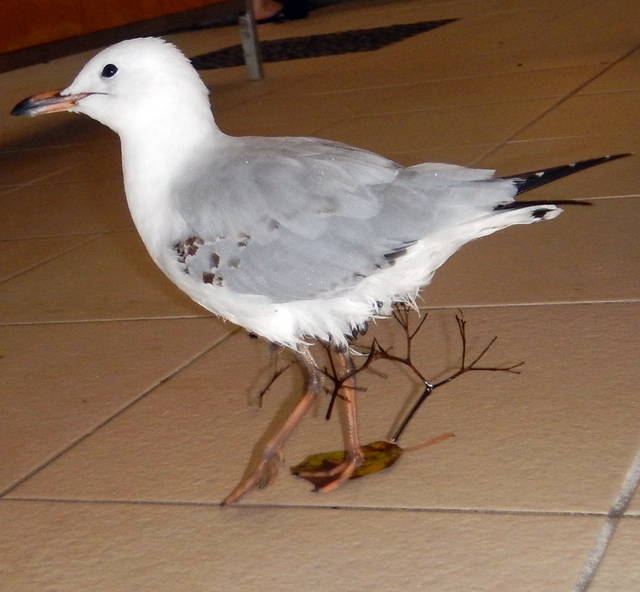Published in the Ocean Watch column, Honolulu Star-Advertiser © Susan Scott
May 13, 2017
HERON ISLAND, Capricorn Cays National Park, Great Barrier Reef >> After voyaging from Pancake Creek to the Gladstone Marina, where we planned to set sail for Heron Island, a gale appeared. Not only did it pack sustained winds of more than 30 mph, the storm front promised to stick around for a week.
Since sailing Honu was out of the question in that weather, I booked two nights at the Heron Island Resort, traveling the 42 miles to the island aboard the resort’s fast ferry.
 Sticky Pisonia seeds are matted in the rear feathers of this immature silver gull that appeared
Sticky Pisonia seeds are matted in the rear feathers of this immature silver gull that appeared
near the Heron Island Resort during a storm on Heron Island, off the Great Barrier Reef.
The storm lent itself to the discovery of how wild animals protect themselves in harsh
weather as well as ample opportunities to see such creatures in their natural habitat.
©2017 Susan Scott
Heron Island Resort, operating since 1932, is well known in Australia because it’s one of the few places, besides a boat, where people can stay out on the reef. The oval island, about a half-mile long and quarter- mile wide, also hosts the Great Barrier Reef’s first marine biology research station, built in 1951.
Coral reef encircles the island, creating a turquoise lagoon that laps onto a continuous white-sand beach, and the island’s center supports a lush tropical forest. All of the area is much loved by researchers and visitors alike because of the abundant marine animals that peacefully share their space with humans.
When the storm proved to be the edge of a cyclone that struck nearby New Caledonia, the ferry ride back to the mainland was deemed unsafe. Two nights on Heron Island became a glorious three.
Soon after we arrived, we walked the beach around the island and in one area saw a carpet of rays in the shallow water. “I stopped counting at 81,” a man said as we passed, gaping. Eagle rays, shovel-nose rays and several species of stingrays come near the island at high tide, wiggling into the sand to eat buried shrimp, crabs and snails.
The forest side of the beach contained endless craters dug months ago by female green and loggerhead turtles to lay their eggs. Walking the beach at sunset to see turtle hatchlings race to the water was a popular, if heartbreaking, activity. Silver gulls snatched the baby turtles as fast as they appeared.
Another of Heron’s harsh wildlife scenes comes from the island’s carnivorous tree, called a Pisonia, which bears sticky, branched seeds. Seabirds called noddies nest by the thousands (200,000 at peak) in the tall leafy trees. When the seeds tangle chicks’ feathers, the birds fall, and their decomposing bodies fertilize the trees.
We saw struggling wedge-tailed shearwater fledglings lethally entangled in Pisonia seeds.
Craig and I went snorkeling twice in that blowy weather, and even with wind and sand blasting our legs and rain pelting our clothes, we walked around and around the island as often as possible, watching wild animals cope with a storm.
How extraordinary is Heron Island? As we left on the ferry for the mainland, we promised we would be back.